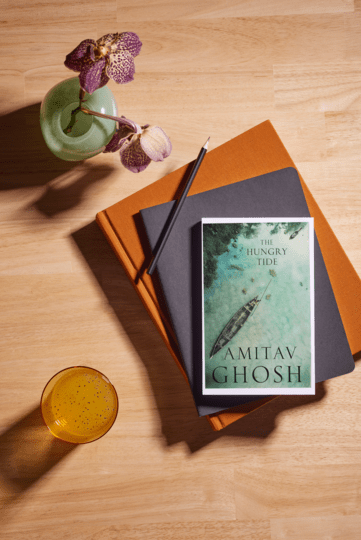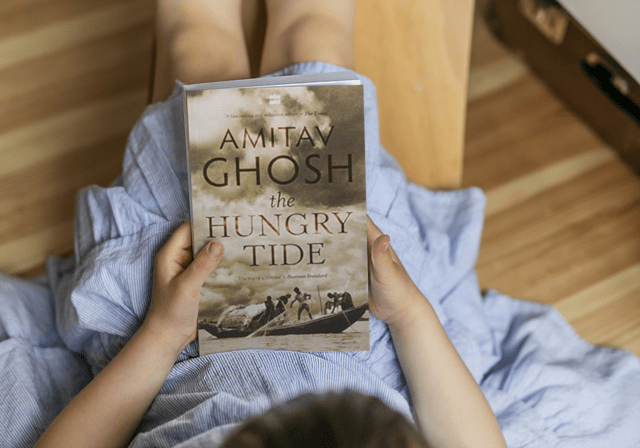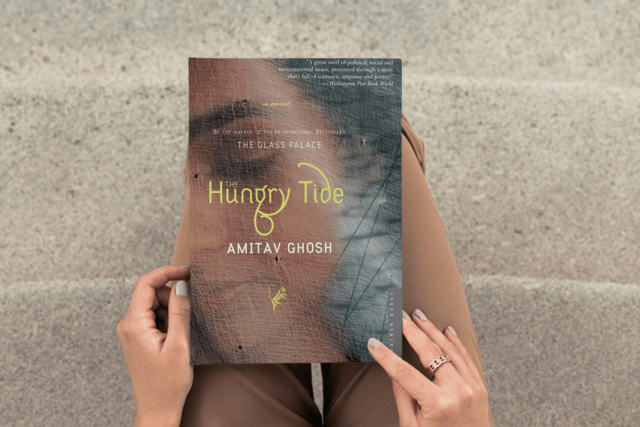For readers of literary fiction, no introduction is needed to works of Amitav Ghosh. He is an acclaimed author of many popular works, has won many accolades including the Padma Shri, Jnanpith and Sahitya Akademi Awards. He has given us many thought-provoking books including the popular triology starting with the Sea of Poppies.
| Book Title | : | The Hungry Tide |
| Author | : | Amitav Ghosh |
| Published by | : |
HarperCollins ( 2004) Viking ( 2008) |
| # of Pages | : | 400 (Paperback) 439; 2178KB (Kindle EBook) 961 Minutes (Audiobook) |
| # of Chapters | : | 65 |
| Purchase Link(s) | : |
In this post, we are visiting one of his earlier works, set int he tide country that exists where the rivers flow into Bay of Bengal and form the tidal world of the Sundarbans. Recently, I had a chance to read this book and here are our views on this book on behalf of Team Thinkerviews.
This Is Here In For You
Book Cover:
Let us take a look at the cover page of this book.

The Hungry Tide by Amitav Ghosh | Book Cover
The cover page of this book is following the latest minimalistic trend of using white, red and black colors to show line drawings and form the title details. It is an elegant cover page that would be attractive to some browsers.
Storyline:
Piya is a marine biologist making her way towards Sundarbans on a train from Kolkata. On the train, she meets Kanai who is also going there to visit his aunt Nilima, fondly known as Mashima by the locals. She has lived most of her life on the island of Lucibari and has been instrumental in providing some amenities on the island when it comes to health and livelihood of its inhabitants. Although Kanai invites Piya to visit Lucibari, neither has much expectations for such a visit to take place.
Kanai arrives in Lucibari and finds that Nilima invited him to visit, because she found a manuscript written by her late husband. As Kanai reads through this account of the last few months of her uncle’s life, it prepares a backdrop for current events.
Piya’s first day on her venture to track the rare and endangered river dolphins that live in these waters goes disastrously wrong, when she finds herself first on a boat with couple of untrustworthy men, and later in the crocodile infested waters when she topples over. She is saved by a local fisherman in the nearby boat, namely Fokir, who is on a person pilgrimage to the island of Garjontola along with his young son Tutul.
As Piya travels with them on their little makeshift craft, they begin to develop an understanding of each other, in spite of not having a language in common. It is here that Piya discovers a pool that seems to be a regular habitat of the Orcaella she is researching and she can envisage years worth of research ahead of herself to study and capture their life patterns.
It so happens that Fokir’s wife Moyna is training to be a nurse in the hospital run by the Badabon trust on Lucibari, and so after a couple of days Piya arrives on Nilima’s doorstep. She then organizes another field trip to go with a bigger boat driven by Horen Naskor and smaller boat by Fokir back to Garjontola. Kanai offer to go with her as an interpreter, and so they all traverse the tide country together.
But none of them can foresee the currents binding them all together with each other, neither can they know that a storm is coming their way that would leave devastation in its wake.
Views and Reviews:
First published in 2004, this book is in some ways different from the author’s later works including the popular Sea of Poppies trilogy, and in some ways it feels familiar reading. With the landscape of folklore that blends cultures, myths and faiths, the author brings together an unlikely trio of characters.

The Hungry Tide by Amitav Ghosh | Book Cover
And the connecting thread through them is the continued struggle of humans to survive – in whatever landscape they happen to be. And what it costs to ecosystems, natural resources and other species.
Set in the Sundarbans, the book beautifully brings to life the tide country, where lives are transient and mercurial like the landscape they populate.
In the tide country, wheel of time spins too fast; rivers stray from week to week, and islands are made and unmade in days. In other places forests take centuries, even millenia, to regenerate; but mangroves can recolonize a denuded island in ten to fifteen years.
It has seen its share of dreamers – dating back to the colonial settler era when men dreamed of it becoming a futuristic heaven of peace and prosperity to the refugee settlers and their clash with the authorities in the 1970s:
He was a dreamer. He wanted to build a place where men and women could be farmers in the morning, poets in the afternoon and carpenters in the evening.
To build something is not the same as dreaming of it. Building is always a matter of well chosen compromises.
The book is rich with characters that exhibit the human spirit for survival in the daily struggle with the nature. But it is the unambitious, untethered Piya that leads us through this country where she does not know the language, but is following an unacknowledged passion that blooms into the purpose of her life and future:
Who would have thought it would be so intensely satisfying to have your future resolved, to know what you were going to be doing next year and the year after that until who knew when? And yes, it was true that whatever came of it would not revolutionise the sciences, or even a minor branch of them, but it was also true that if she were able to go through with it – even a part of it – it would be as fine a piece of descriptive science as any. It would be enough as an alibi for life, it would do; she would not need to apologise for how she had spent her time on this earth.
While she doesn’t have to speak all the time, she can observe and see the remarkable things that nature does on everyday basis and ideas that are conveyed into words that hardly convey the enormous complexity of how every creature in nature plays a part that is of massive impact:
The crabs were a sanitation department and a janitorial team rolled into one: they kept the mangroves alive by removing their leaves and litter; without them the trees would choke on their own debris. Didn’t they represent some fantastically large prportionof the system’s biomass? Didn’t they outweight even the trees and the leaves? Weren’t they the keystone species of the entire ecosystem in the tide country?
And while she idolizes Fokir as a fellow naturalist for a little while, we also come to see that for Fokir, there is no separation between life and livelihood. Every day he lives is steeped into the history, geography and unbroken heritage of the land and people which is all he knows. He may fight off crocodiles and tigers, catch crab, build boats and live on those just as easily as on islands, attempt to survive stroms and love his wife and son with all his heart, as men of these parts would have done always.
In Kanai and to some extent Nilima, we see the pragmatic, educated middle class that builds a life in cities and villages, not always so dependent on the nature but more on the human built infrastructures. And we also see how Nirmal struggled with the realities of revolutionaries, with depression, with an innate sense of futility as he grew older:
The true tragedy of a routinely spent life is that its wastefulness does not become apparent till its too late.
Age teaches you to recognize the signs of death. You dot see them suddenly; you become aware of them very slowly over a period of many, many years.
It dawned on me that the tide country’s faith is something like one of the great mohonas, a meeting not just of many rivers, but a roundabout people can use to pass in many directions – from country to country and even between faiths and religions.
As these different characters are drawn together, the author shows us the differences between those who survive in wild places and those who deal with more human predators than animals.
Fear was not – contrary to what was often said – an instinct. It was something learnt, something that accumulated in the mind, through knowledge, experience and upbringing. Nothing was harder to share than another person’s fear.

The Hungry Tide by Amitav Ghosh | Book Cover
While the book is filled with poetry and beauties of the landscape and characters that make it a delightful read, it does fell stretched in places especially in the second half. The storm does bring that sense of urgency and leading to an end, but prior to that there are segments that slow down the pace of the book.
Summary:
A tale of continued struggle for survival that sees generations ebb and flow in the place that exists between the tides of the ocean and riverlands…
ThinkerViews Rating:
Around 7 stars out of 10.
Quick Purchase Links:
- Buy - The Hungry Tide by Amitav Ghosh - Kindle EBook - Amazon IN
- Buy - The Hungry Tide by Amitav Ghosh - Audiobook - Amazon IN
- Buy - The Hungry Tide by Amitav Ghosh - Paperback - Amazon US
- Buy - The Hungry Tide by Amitav Ghosh - Audiobook - Amazon US
Over To You:
If you already have read the book do share your remarks and thoughts via comments below. Does this review help you in making your decision to buy or read the book? Do not forget to share this article with your friends over various social networks. Please follow/subscribe us on various Social networks like Twitter, Facebook, YouTube, Spotify, Amazon Prime Music, Audible, and others. And yes, you may like to subscribe to our RSS feeds to get latest updates for the site to land right in your mail box.
 ThinkerViews – Views And Reviews Personal views and reviews for books, magazines, tv serials, movies, websites, technical stuff and more.
ThinkerViews – Views And Reviews Personal views and reviews for books, magazines, tv serials, movies, websites, technical stuff and more.



